The ceiling is often called the “fifth wall” of a room, yet it remains one of the most overlooked elements in bedroom design. A well designed modern bedroom ceiling can dramatically transform your space, creating visual interest, enhancing lighting, and establishing the overall ambiance of your sanctuary.
Bedroom Ceiling design trends are moving toward clean lines, integrated technology, and sustainable materials that blend functionality with aesthetic appeal. From minimalist approaches to statement making features, modern ceiling designs offer endless possibilities to elevate your bedroom’s style while addressing practical needs like lighting, ventilation, and acoustics.
What Purpose Of Bedroom Ceiling?
The modern bedroom ceiling embraces simplicity, functionality, and visual harmony. The key principles include clean geometric lines, neutral color palettes, and the strategic use of negative space to create a sense of openness. Contemporary designs often incorporate multiple levels, indirect lighting, and seamless integration of fixtures and technology.
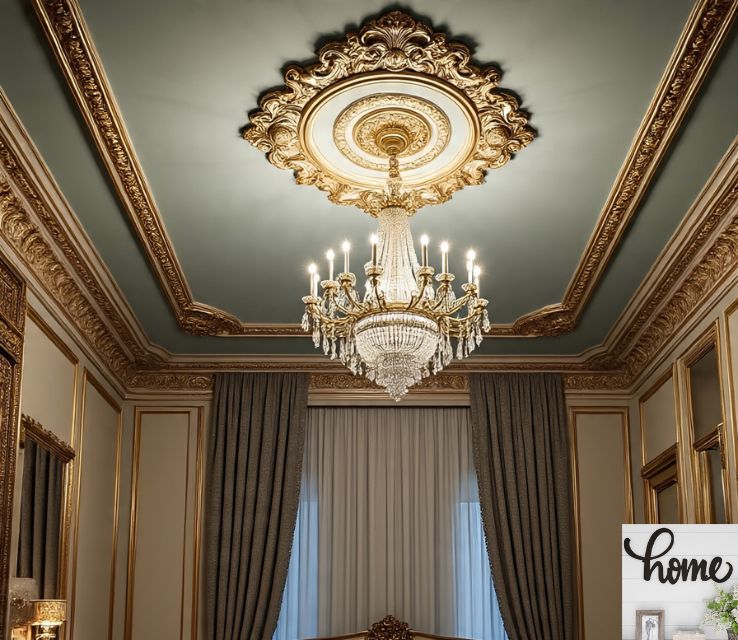
The beauty of modern design lies in its versatility. Whether your bedroom follows a minimalist aesthetic or incorporates bold architectural elements, modern ceiling treatments can complement and enhance your existing decor. The focus is on creating a cohesive look that doesn’t overwhelm the space but rather adds subtle sophistication and visual interest.
Simple Bedroom Ceiling Design Ideas
Simple bedroom ceiling doesn’t mean boring or basic. Often, the most effective designs are those that appear effortless while delivering maximum impact. A fresh coat of paint in a crisp white or soft neutral tone can instantly modernize your ceiling and make the room feel larger and brighter. Adding subtle texture through techniques like color washing or using matte versus glossy finishes can create depth without overwhelming the space.
Coffered ceilings offer another simple yet elegant option, creating geometric patterns through recessed panels. These can be painted in the same color as the ceiling for a monochromatic look or contrasted with darker tones for more definition. Linear lighting integrated into simple ceiling channels provides both ambient and task lighting while maintaining clean, modern lines.
Small Bedroom Ceiling Design Solutions
A small bedroom ceiling requires careful consideration to avoid making the space feel cramped or overwhelming. The key is to create the illusion of height and space while incorporating functional elements. Light colors, particularly whites and soft pastels, reflect light and make ceilings appear higher than they actually are.
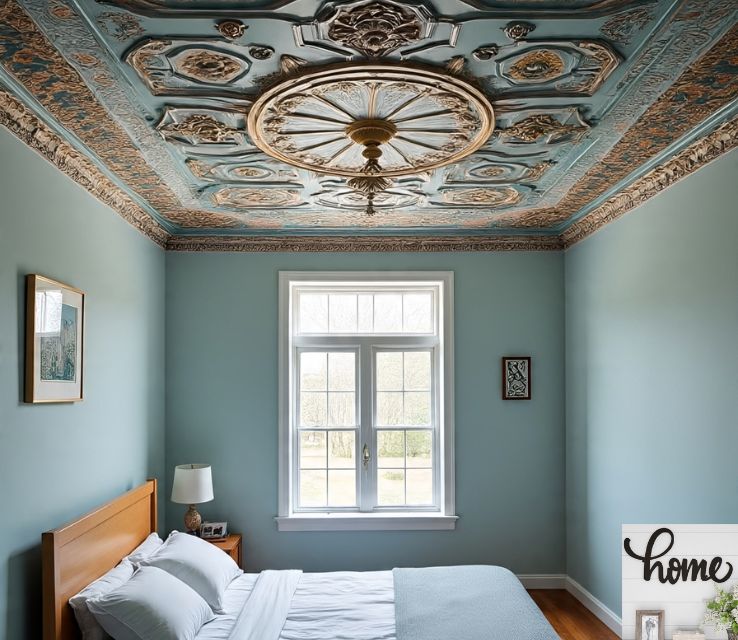
Vertical elements like tall, narrow light fixtures or vertical paneling can draw the eye upward, creating the perception of increased height. Mirrors strategically placed on or near the ceiling can also amplify light and space. For unique modern small bedroom ceiling design, consider incorporating unexpected elements like a subtle metallic accent strip or geometric cutouts that add interest without overwhelming the compact space.
10×10 Bedroom Ceiling Design Strategies
A 10×10 bedroom ceiling presents unique opportunities and challenges. With 100 square feet of ceiling space, you have enough room to create impact without the design feeling disproportionate. This size room works beautifully with tray ceilings, which add architectural interest and can accommodate perimeter lighting for a soft, ambient glow.
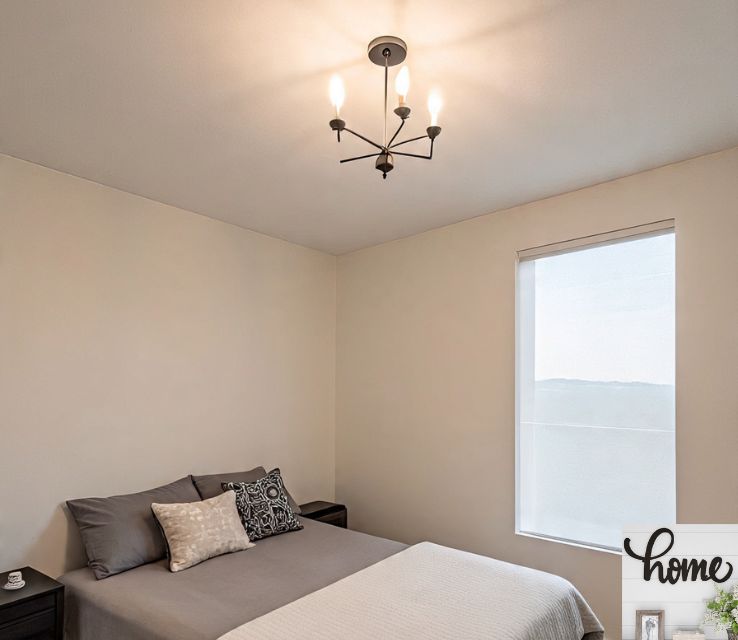
Consider asymmetrical designs that create visual movement across the ceiling. A modern interpretation might include a floating ceiling panel positioned over the bed area, creating a defined sleeping zone while incorporating integrated lighting. Wooden beam accents, either real or decorative, can add warmth and texture to a 10×10 space without overwhelming it.
Luxury Modern Bedroom Ceiling Design Elements
Luxury modern bedroom design elevates your space through premium materials, sophisticated lighting systems, and custom architectural details. High end materials like natural wood planks, metal panels, or textured plaster create rich visual and tactile experiences. These materials can be combined in unexpected ways, such as incorporating a leather wrapped ceiling medallion or brushed metal geometric inlays.
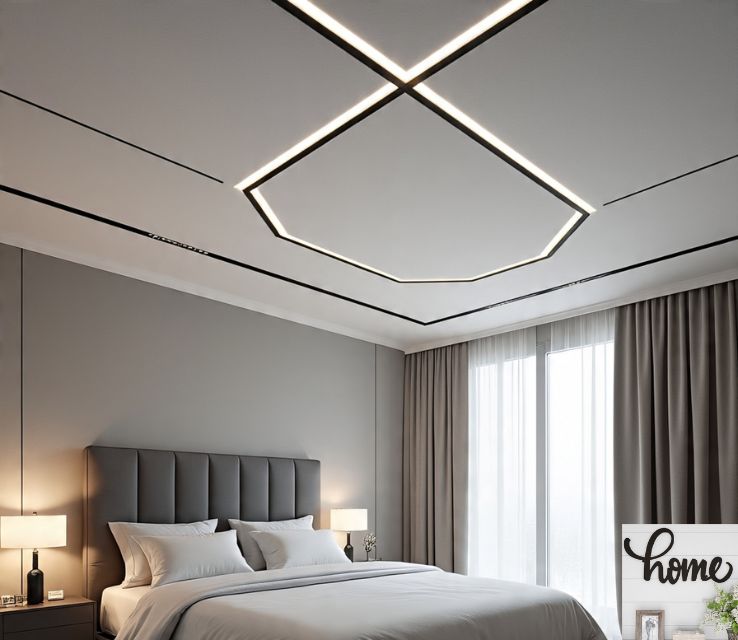
Integrated smart lighting systems allow for customizable ambiance throughout the day, with options for color temperature adjustment and dimming controls. Luxury designs often feature hidden LED strips that create floating effects, making ceiling elements appear to hover weightlessly above the room. Custom millwork and handcrafted details add uniqueness that cannot be replicated in mass-produced designs.
Master Bedroom Ceiling Design Considerations
Master bedroom ceiling should reflect the importance of this primary retreat space. These rooms typically have more generous proportions, allowing for dramatic design elements that would overwhelm smaller spaces. Vaulted or cathedral ceilings can be enhanced with exposed beams, creating a rustic-modern hybrid that feels both grand and intimate.
Multiple lighting zones are essential in master bedrooms, with ceiling designs incorporating various fixture types for reading, ambient lighting, and accent illumination. Consider incorporating a statement chandelier or pendant light as a focal point, balanced by recessed lighting for practical illumination.
Bedroom Ceiling Design with Fan Integration
Bedroom ceiling with fan integration requires careful planning to ensure both aesthetic appeal and functional airflow. Modern ceiling fans have evolved far beyond basic utility fixtures, now available in sleek, contemporary designs that complement modern interiors. The key is selecting fans that align with your overall design aesthetic while providing adequate air circulation.
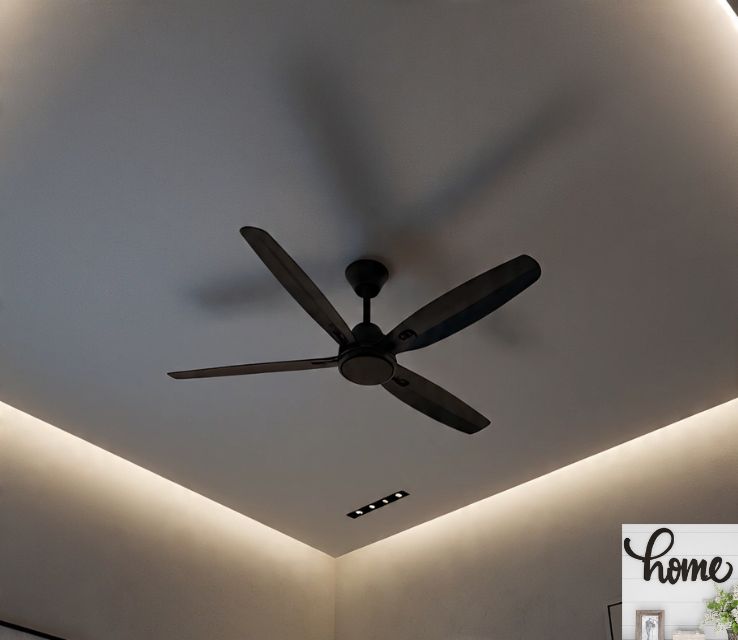
Flush mount fans work excellently in rooms with lower ceilings, while rooms with higher ceilings can accommodate dramatic statement fans with longer downrods. Consider fans with integrated lighting to reduce the number of fixtures needed on your ceiling. Some modern designs feature retractable blades that disappear when not in use, maintaining clean ceiling lines while providing cooling when needed.
Bedroom Ceiling Design Trends for 2025
Bedroom ceiling 2025 trends emphasize sustainability, technology integration, and biophilic design elements. Natural materials like reclaimed wood, bamboo, and cork are gaining popularity for their environmental benefits and warm aesthetic appeal. These materials can be incorporated through ceiling planks, panels, or accent features that add texture and visual interest.
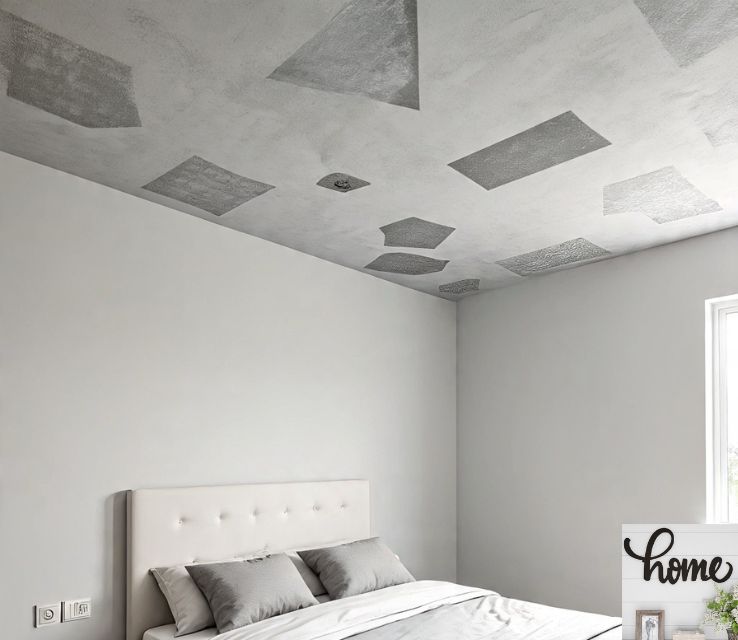
Smart home integration continues to expand, with ceilings incorporating speakers, sensors, and adaptive lighting systems that respond to occupancy and natural light levels. Biophilic design brings nature indoors through living walls that extend to ceiling elements, integrated planters, or nature inspired patterns and textures.
Lighting Integration in Modern Ceiling Design
Proper lighting integration is crucial for successful modern ceiling design. Layered lighting approaches combine ambient, task, and accent lighting to create flexible, functional spaces. LED strip lighting hidden in ceiling coves or channels provides soft, indirect illumination that highlights architectural features without creating harsh shadows.
Pendant lights and chandeliers serve as both functional fixtures and decorative elements, drawing attention to specific areas while contributing to the overall design aesthetic. Smart dimming systems allow for adjustment throughout the day, supporting circadian rhythms and creating appropriate ambiance for different activities.
Color and Texture Strategies
Color and texture play vital roles in modern bedroom ceiling. While white remains popular for its space-enhancing properties, contemporary designs increasingly incorporate subtle colors that complement the overall room palette. Soft grays, warm beiges, and muted pastels can add sophistication without overwhelming the space.
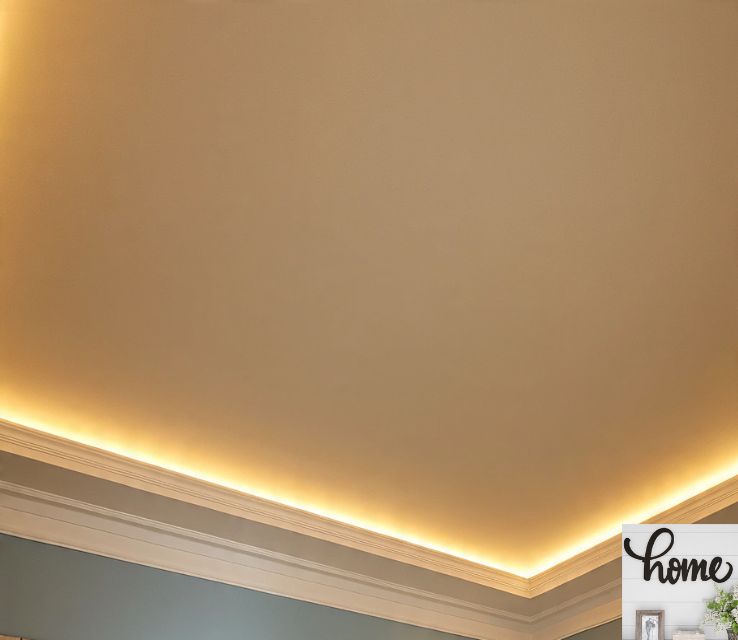
Textural elements add visual and tactile interest to otherwise flat surfaces. Techniques like skip trowel texturing, venetian plaster, or wallpaper with subtle patterns can create depth and dimension. Metallic accents through paint techniques or actual metal elements reflect light and add luxury touches. The key is maintaining balance between texture and smoothness to avoid visual chaos.
Budget Friendly Modern Ceiling Updates
Achieving a modern bedroom ceiling doesn’t require a complete renovation or significant budget. Simple updates like painting existing textures, adding LED strip lighting, or installing decorative ceiling medallions can create dramatic improvements at minimal cost. Removable wallpaper designed for ceilings offers an affordable way to add pattern and interest without permanent commitment.
DIY-friendly options include installing foam ceiling tiles that mimic more expensive materials, creating geometric patterns with painter’s tape and contrasting paint colors, or adding floating shelves that extend from walls onto the ceiling plane. These approaches allow for creativity and personalization while staying within budget constraints.
Professional Installation vs. DIY Approaches
While some ceiling design elements can be successfully DIY projects, others require professional expertise for safety and optimal results. Electrical work, major structural modifications, and installation of heavy fixtures should always be handled by licensed professionals. Painting, installing lightweight decorative elements, and simple trim work can often be accomplished by capable DIY enthusiasts.

Consider the long-term implications of your choices. Professional installation may have higher upfront costs but often results in better durability, proper installation, and warranty coverage. For complex designs involving multiple trades (electrical, carpentry, painting), professional coordination ensures proper sequencing and integration of different elements.
Maintenance and Longevity Considerations
Modern bedroom ceiling should balance aesthetic appeal with practical maintenance requirements. Smooth surfaces are easier to clean and maintain than heavily textured ones, particularly in bedrooms where dust and allergens can accumulate. Consider the accessibility of light fixtures and other ceiling elements for bulb changes and cleaning.
Choose materials and finishes that will age gracefully and remain stylish over time. While trendy elements can add excitement to a design, ensure that core structural and architectural elements have lasting appeal. Quality materials and proper installation contribute to longevity and reduce the need for frequent updates or repairs.
Read More: Best Shade Loving Plants to Transform Your Garden
Conclusion
Modern bedroom ceiling design offers tremendous potential to transform your personal sanctuary into a space that reflects your style while enhancing comfort and functionality. Remember that successful ceiling design is about more than just visual appeal.
Consider how your choices will affect lighting quality, room acoustics, maintenance requirements, and long term satisfaction. With careful planning and attention to detail, your bedroom ceiling can become a defining feature that enhances both the beauty and functionality of your most personal space.
FAQs
What are the most popular modern bedroom ceiling design trends for 2025?
Bedroom ceiling design 2025 trends focus on sustainable materials like reclaimed wood and bamboo, integrated smart lighting systems, biophilic design elements, and curved organic shapes that replace rigid geometric forms. Technology integration and adaptive lighting that responds to natural cycles are also becoming increasingly popular.
How can I make a small bedroom ceiling appear higher?
For small bedroom ceiling design, use light colors to reflect light and create the illusion of height. Incorporate vertical design elements, avoid heavy textures or dark colors, and consider strategic mirror placement. Unique modern small bedroom ceiling design can include subtle metallic accents or geometric cutouts that add interest without overwhelming the space.
What is a false ceiling?
A false ceiling (also known as a drop ceiling or suspended ceiling) is a secondary ceiling installed below the main structural ceiling. It helps in improving aesthetics, hiding wires/pipes, insulating heat, and enhancing lighting.
